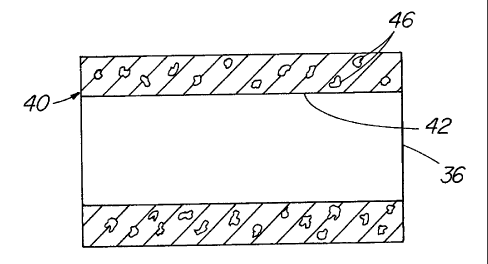Some of the information on this Web page has been provided by external sources. The Government of Canada is not responsible for the accuracy, reliability or currency of the information supplied by external sources. Users wishing to rely upon this information should consult directly with the source of the information. Content provided by external sources is not subject to official languages, privacy and accessibility requirements.
Any discrepancies in the text and image of the Claims and Abstract are due to differing posting times. Text of the Claims and Abstract are posted:
| (12) Patent: | (11) CA 2403428 |
|---|---|
| (54) English Title: | INTRODUCER SHEATH |
| (54) French Title: | GAINE D'INTRODUCTION |
| Status: | Expired |
| (51) International Patent Classification (IPC): |
|
|---|---|
| (72) Inventors : |
|
| (73) Owners : |
|
| (71) Applicants : |
|
| (74) Agent: | BLAKE, CASSELS & GRAYDON LLP |
| (74) Associate agent: | |
| (45) Issued: | 2008-05-13 |
| (86) PCT Filing Date: | 2001-03-16 |
| (87) Open to Public Inspection: | 2001-09-27 |
| Examination requested: | 2003-03-31 |
| Availability of licence: | N/A |
| (25) Language of filing: | English |
| Patent Cooperation Treaty (PCT): | Yes |
|---|---|
| (86) PCT Filing Number: | PCT/US2001/008432 |
| (87) International Publication Number: | WO2001/070324 |
| (85) National Entry: | 2002-09-23 |
| (30) Application Priority Data: | ||||||
|---|---|---|---|---|---|---|
|
An introducer sheath
(30) having a short distal tip section (34,
40) that is highly radiopaque. The distal
tip section may be of FEP with 20 %
to 75 % by weight tungsten particulate
filler, and may be initially a separate
member (40) and bonded to the sheath
shaft distal end (32).
La présente invention concerne une gaine d'introduction (30) présentant une partie terminale distale courte (34, 40) hautement radio-opaque. Cette partie terminale distale peut être composée d'éthylène-propylène fluoré (FEP) et entre 20 % et 75 % en poids de charge particulaire de tungstène, et peut être initialement un élément séparé (40) raccordé à l'extrémité distale (32) de l'axe de la gaine.
Note: Claims are shown in the official language in which they were submitted.
Note: Descriptions are shown in the official language in which they were submitted.

For a clearer understanding of the status of the application/patent presented on this page, the site Disclaimer , as well as the definitions for Patent , Administrative Status , Maintenance Fee and Payment History should be consulted.
| Title | Date |
|---|---|
| Forecasted Issue Date | 2008-05-13 |
| (86) PCT Filing Date | 2001-03-16 |
| (87) PCT Publication Date | 2001-09-27 |
| (85) National Entry | 2002-09-23 |
| Examination Requested | 2003-03-31 |
| (45) Issued | 2008-05-13 |
| Expired | 2021-03-16 |
There is no abandonment history.
| Fee Type | Anniversary Year | Due Date | Amount Paid | Paid Date |
|---|---|---|---|---|
| Registration of a document - section 124 | $100.00 | 2002-09-23 | ||
| Application Fee | $300.00 | 2002-09-23 | ||
| Maintenance Fee - Application - New Act | 2 | 2003-03-17 | $100.00 | 2002-09-23 |
| Request for Examination | $400.00 | 2003-03-31 | ||
| Maintenance Fee - Application - New Act | 3 | 2004-03-16 | $100.00 | 2003-12-18 |
| Maintenance Fee - Application - New Act | 4 | 2005-03-16 | $100.00 | 2005-03-10 |
| Maintenance Fee - Application - New Act | 5 | 2006-03-16 | $200.00 | 2006-01-11 |
| Maintenance Fee - Application - New Act | 6 | 2007-03-16 | $200.00 | 2006-12-20 |
| Maintenance Fee - Application - New Act | 7 | 2008-03-17 | $200.00 | 2007-12-18 |
| Final Fee | $300.00 | 2008-02-27 | ||
| Maintenance Fee - Patent - New Act | 8 | 2009-03-16 | $200.00 | 2008-12-18 |
| Maintenance Fee - Patent - New Act | 9 | 2010-03-16 | $200.00 | 2010-02-08 |
| Maintenance Fee - Patent - New Act | 10 | 2011-03-16 | $250.00 | 2011-02-16 |
| Maintenance Fee - Patent - New Act | 11 | 2012-03-16 | $250.00 | 2012-02-17 |
| Maintenance Fee - Patent - New Act | 12 | 2013-03-18 | $250.00 | 2013-02-14 |
| Maintenance Fee - Patent - New Act | 13 | 2014-03-17 | $250.00 | 2014-02-17 |
| Maintenance Fee - Patent - New Act | 14 | 2015-03-16 | $250.00 | 2015-02-12 |
| Maintenance Fee - Patent - New Act | 15 | 2016-03-16 | $450.00 | 2016-02-10 |
| Maintenance Fee - Patent - New Act | 16 | 2017-03-16 | $450.00 | 2017-02-14 |
| Maintenance Fee - Patent - New Act | 17 | 2018-03-16 | $450.00 | 2018-02-13 |
| Maintenance Fee - Patent - New Act | 18 | 2019-03-18 | $450.00 | 2019-02-19 |
| Maintenance Fee - Patent - New Act | 19 | 2020-03-16 | $450.00 | 2020-02-19 |
Note: Records showing the ownership history in alphabetical order.
| Current Owners on Record |
|---|
| COOK INCORPORATED |
| SABIN CORPORATION |
| Past Owners on Record |
|---|
| DREWES, DAVID A., JR. |
| EELLS, SCOTT E. |
| GRAF, MATTHEW M. |